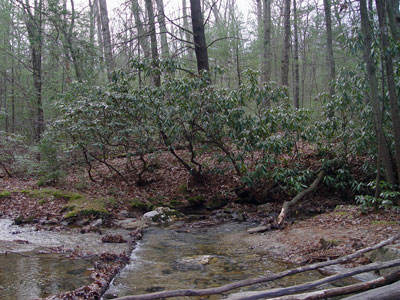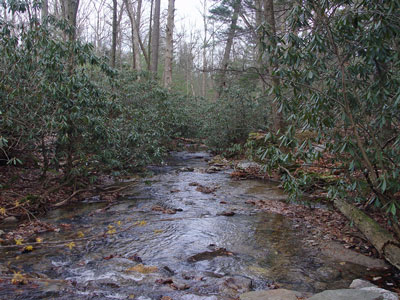DACF Home → Bureaus & Programs → Maine Natural Areas Program → Communities, Plants, and Animals → Rare Plants → Rhododendron maximum

Rhododendron maximum L.
Great Rhododendron
- State Rank: S1
- Global Rank: G5
- State Status: Threatened
Habitat: Damp woods, swamps, and pond margins. [Conifer forest (forest, upland); Hardwood to mixed forest (forest, upland)]
Range: Georgia and Alabama to New England, New York, and west to Ohio.
Aids to Identification: Great rhododendron, a close relative of rhododendrons used in the landscaping trade, is one of the few upland shrubs in Maine that have evergreen leaves. The leaves are leathery and oblong, up to 15 cm in length, and may curl and droop in cold weather. The large, flaring, pinkish-white flowers occur in clusters, much like those of cultivated rhododendrons. Individuals in suboptimal conditions may not flower.
Ecological characteristics: This understory shrub is one of the dominant species in Appalachian oak forests south of Maine but reaches its northern limit here. In Maine, it grows in mixed woods containing hemlock, white pine, beech, and/or red maple. It is frequently planted as an ornamental and occasionally escapes as one or a few individuals; these are not considered natural populations.

Phenology: Flowers late June - early July (usually early July in Maine).
Family: Ericaceae
Synonyms: None noted.
Known Distribution in Maine: This rare plant has been documented from a total of 9 town(s) in the following county(ies): Cumberland, Somerset, Washington, York.
Reason(s) for rarity: At northern limit of range; not rare south of New England.
Conservation considerations: Maine stands are vulnerable to depredation by nature and humans alike. Also considered rare in New Hampshire, Vermont, and Massachusetts. This plant is restricted statewide to southern Maine, and known populations are vulnerable to conversion of their habitat to residential or commercial use. This is believed to be partly responsible for its rarity in Maine. Deer browse has been known to decimate individual plants.